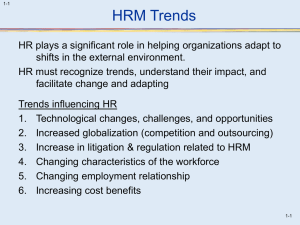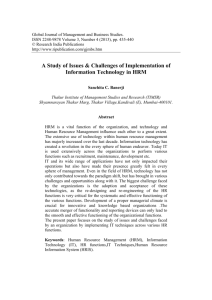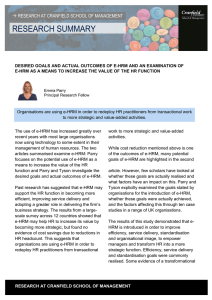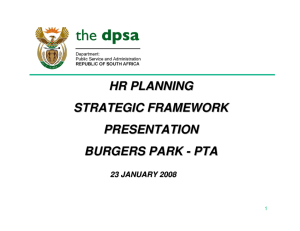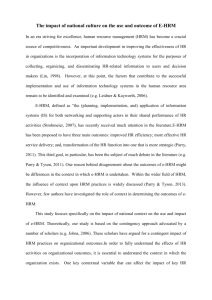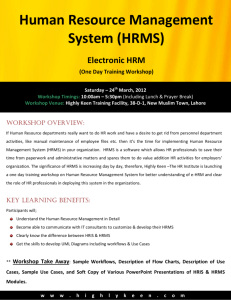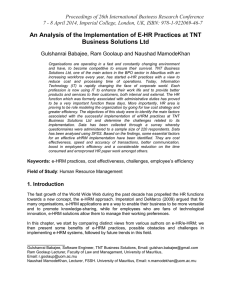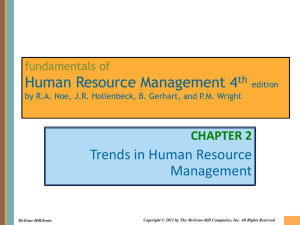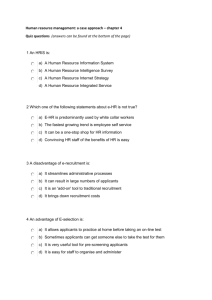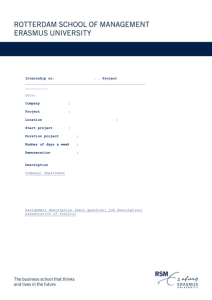Integration of People, Process and Technology A case for e-HRM adoption
advertisement
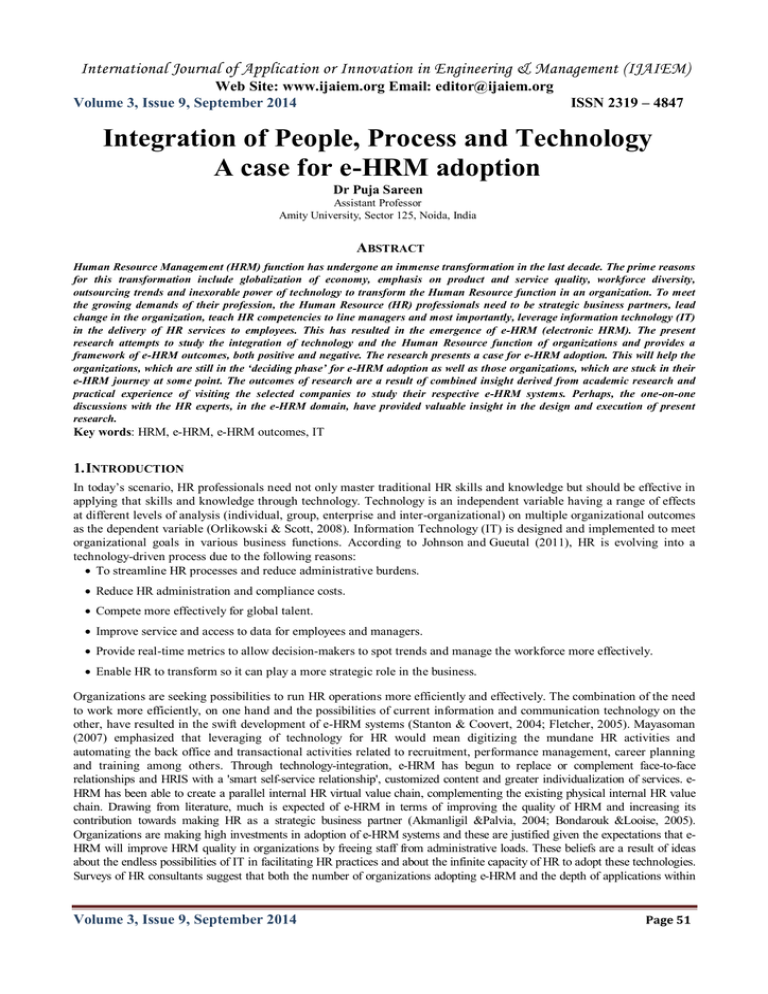
International Journal of Application or Innovation in Engineering & Management (IJAIEM) Web Site: www.ijaiem.org Email: editor@ijaiem.org Volume 3, Issue 9, September 2014 ISSN 2319 – 4847 Integration of People, Process and Technology A case for e-HRM adoption Dr Puja Sareen Assistant Professor Amity University, Sector 125, Noida, India ABSTRACT Human Resource Management (HRM) function has undergone an immense transformation in the last decade. The prime reasons for this transformation include globalization of economy, emphasis on product and service quality, workforce diversity, outsourcing trends and inexorable power of technology to transform the Human Resource function in an organization. To meet the growing demands of their profession, the Human Resource (HR) professionals need to be strategic business partners, lead change in the organization, teach HR competencies to line managers and most importantly, leverage information technology (IT) in the delivery of HR services to employees. This has resulted in the emergence of e-HRM (electronic HRM). The present research attempts to study the integration of technology and the Human Resource function of organizations and provides a framework of e-HRM outcomes, both positive and negative. The research presents a case for e-HRM adoption. This will help the organizations, which are still in the ‘deciding phase’ for e-HRM adoption as well as those organizations, which are stuck in their e-HRM journey at some point. The outcomes of research are a result of combined insight derived from academic research and practical experience of visiting the selected companies to study their respective e-HRM systems. Perhaps, the one-on-one discussions with the HR experts, in the e-HRM domain, have provided valuable insight in the design and execution of present research. Key words: HRM, e-HRM, e-HRM outcomes, IT 1. INTRODUCTION In today’s scenario, HR professionals need not only master traditional HR skills and knowledge but should be effective in applying that skills and knowledge through technology. Technology is an independent variable having a range of effects at different levels of analysis (individual, group, enterprise and inter-organizational) on multiple organizational outcomes as the dependent variable (Orlikowski & Scott, 2008). Information Technology (IT) is designed and implemented to meet organizational goals in various business functions. According to Johnson and Gueutal (2011), HR is evolving into a technology-driven process due to the following reasons: To streamline HR processes and reduce administrative burdens. Reduce HR administration and compliance costs. Compete more effectively for global talent. Improve service and access to data for employees and managers. Provide real-time metrics to allow decision-makers to spot trends and manage the workforce more effectively. Enable HR to transform so it can play a more strategic role in the business. Organizations are seeking possibilities to run HR operations more efficiently and effectively. The combination of the need to work more efficiently, on one hand and the possibilities of current information and communication technology on the other, have resulted in the swift development of e-HRM systems (Stanton & Coovert, 2004; Fletcher, 2005). Mayasoman (2007) emphasized that leveraging of technology for HR would mean digitizing the mundane HR activities and automating the back office and transactional activities related to recruitment, performance management, career planning and training among others. Through technology-integration, e-HRM has begun to replace or complement face-to-face relationships and HRIS with a 'smart self-service relationship', customized content and greater individualization of services. eHRM has been able to create a parallel internal HR virtual value chain, complementing the existing physical internal HR value chain. Drawing from literature, much is expected of e-HRM in terms of improving the quality of HRM and increasing its contribution towards making HR as a strategic business partner (Akmanligil &Palvia, 2004; Bondarouk &Looise, 2005). Organizations are making high investments in adoption of e-HRM systems and these are justified given the expectations that eHRM will improve HRM quality in organizations by freeing staff from administrative loads. These beliefs are a result of ideas about the endless possibilities of IT in facilitating HR practices and about the infinite capacity of HR to adopt these technologies. Surveys of HR consultants suggest that both the number of organizations adopting e-HRM and the depth of applications within Volume 3, Issue 9, September 2014 Page 51 International Journal of Application or Innovation in Engineering & Management (IJAIEM) Web Site: www.ijaiem.org Email: editor@ijaiem.org Volume 3, Issue 9, September 2014 ISSN 2319 – 4847 the organizations are continually increasing (Wright & Dyer, 2000; Cedar Crestone, 2005; Lengnick-Hall & Lengnick-Hall, 2006; Martin , Reddington, & Alexander, 2008). According to Esen and Erdogmus (2011), using information and communication technologies in human resource services has become an important strategy to achieve competitive advantage for organizations. Although IT has been widely used in HR function since the 1980’s, this application of technology has to be distinguished from e-HRM. The earlier usage of technology has been in the form of Human Resource Information Systems (HRIS) which were focused on automating the systems used by the HR function itself. 1990’s have seen a significant increase in the number of organizations gathering, storing and analyzing human resources data using HRIS (Ball, 2001; Barron, Chhabra, Hanscome, & Henson 2004; Ngai & Wat, 2006). However, in case of HRIS, its main 'customer' has been HR staff rather than employees or managers. It has been typically used in automating systems such as payroll and personal information, often with little or no attempt to make such data interactive or available to staff outside of HR (Fisher, Schoenfeldt, &Shaw, 2007). Today, internet is entering our everyday lives and is being incorporated into business strategies in an unprecedented manner. 'Internet' simply means a 'network of networks', and is defined as a network of interlinked computers throughout the world operating on a standard protocol which allows data to be transferred between otherwise incompatible machines (Hamill, 1997). Such networks link a wide range of participants (like individuals, companies, organizations, governments, education and research institutions) and supports the transfer of a wide range of data (text, graphics, audio, video and software). With the increasing use of information technologies in HR planning and delivery, the way people in organizations look at the nature and role of HR itself has changed (Roehling, Boswell, Caligiuri, Feldman, Graham, & Guthrie, 2005). In the present times, organizations have increasingly been using web-based applications for HRM purposes and are moving fast in their e-HRM journey. There is an increased usage of new social media such as blogs, wikis, media sharing sites, social networking and the like, which are collectively known as Web 2.0. These media are becoming more widely used by organizations to increase knowledge sharing, improve collaboration and employee voice as well as connect with new generations of employees (Martin & Reddington, 2009). At large, companies in the 21st century have adopted at least one of the following e-HRM technologies: HR Functional Applications, Integrated HR Suite Applications, Interactive Voice Responses, HR Intranet Applications, Employee Self-Service and Manager Self-Service portals, HR Extranet Applications or HR portals (Laumer, Eckhardt, & Weitzel, 2010; Florkowski & Olivas-Lujan, 2006). An interesting phenomenon in the present century is the redistribution of conventional HR functions in the hands of line managers. HR has begun to evaluate self-service applications to help streamline business processes, capture better data and most importantly put information into the hands of those who need it the most: managers and employees. The impetus for this change can in part be attributed to the fact that there are benefits like cost efficiencies among many others which are being offered by high end HR technologies. Interestingly, many of the traditional HR functions have changed into a new set of competencies altogether as many of these can be enhanced or performed using technology (Strohmeier & Kabst, 2009; Waddill & Marquardt, 2011). The influence of internet and browser technology has seen the growth of self-service applications. These are internet based solutions providing employees with a browser interface to relevant HR data and transactions, enabling real time access to their data without leaving their desktop. Employees are able to update their personal details, apply for leave, view their pay details and associated benefits, view internal job vacancies and book training and travel. The tangible and intangible benefits of these solutions have been well documented (Alexander, 2002; McKenna, 2002; Webster & Buchanan, 2002; Khan & Chahar, 2010) and include reduced administrative overheads, freeing up HR staff for more strategic activities, improved data integrity and empowerment of employees. Stone (2005) suggests technological changes influencing e-HRM during the end of this decade will include intelligent self-service systems, interchangeable devices, cognitive software, nanotechnology and the convergence of the internet, digital TV and the wireless technology communication into a vibrant network. ERP and HRM The market of HR technology is flooded with a wide range of stand-alone applications as well as high end ERP systems. ERP is defined as “a packaged business software system that enables a company to manage the efficient and effective use of resources (materials, human resources and finance) by providing a total, integrated solution for the organization’s information-processing needs”(Nah & Lau, 2001, p. 285). This software facilitates, if well implemented, the integration of all the functional information flows across the organization into a single package with a common database. Therefore, it allows easy and immediate access to information regarding inventory, product or customer data and prior history information (Shehab, Sharp, Supramaniam, & Spedding, 2004). In other words, ERP represents an integration of all data and processes of an organization woven together in an intelligent manner using technology into a single unified system. The term ERP originally implied to systems designed to plan the utilization of enterprise-wide resources. Although the acronym ERP originated in the manufacturing environment, today's use of the term ERP systems has much broader scope. ERP systems typically attempt to cover all basic functions of an organization, regardless of the organization's business or charter (Voermans & van Veldhoven, 2007). With advent of ERP, organizations today have a single enterprise wide Volume 3, Issue 9, September 2014 Page 52 International Journal of Application or Innovation in Engineering & Management (IJAIEM) Web Site: www.ijaiem.org Email: editor@ijaiem.org Volume 3, Issue 9, September 2014 ISSN 2319 – 4847 application consisting of modules within, capable of absorbing all their functions under a single umbrella structure where these could speak to each other and co-exist without any adverse impact on their working and efficiency. However, according to Kroenke (2008), in practical terms, the entire process of moving from functional applications to an ERP system is not only difficult but challenging as well. Additionally, the switch to ERP system is expensive and it requires development of new procedures, training and converting data (Zhang & Huang, 2005). On the other hand, some organizations may not invest in ERP for the HR function and use stand-alone applications for HR activities. The key difference between the ERP version and the stand-alone versions is integration. The ERP applications share the same technical architecture, database, look and feel, and processing standards. Major ERP vendors like Infor HCM (Human Capital Management), Microsoft Axapta Human Resource Management III, SAP HCM, Oracle HRMS, Peoplesoft, Adrenalin and others; now offer organizations HR modules that help automate an array of tasks while generating crucial data for enterprise planning and optimization. Today, HR function can leverage from some of the best IT solutions which have been developed specifically keeping in mind the strategic role played by each of the HR processes. Today, technology underpins all the HR functions and can increase their effectiveness. Technology can be used to enhance performance, quicken decision making, enable exchange of knowledge, provide cost savings and offer learning to a broader audience (Olivas-Lujan, Ramirez, & Zapata-Cantu, 2007) .After an in-depth study of the journey of traditional HR towards e-HRM, it can aptly be said that e-HRM helps to create competitive advantage and align the HR function more closely with business or corporate strategy and can achieve the long-term branding and reputational objectives of organizations as well. As mentioned by Fletcher (2005), it is an exciting time to be in e-HRM (cited in Gueutal & Stone, 2005). Therefore, the human resources function in the digital age, the effectiveness of the new systems, arising opportunities and challenges are issues of prime concern. Objective and Methodology The present study primarily seeks to explore and provide a framework of outcomes, both positive and negative, of e-HRM and presents a case for e-HRM adoption to organizations. This will help the organizations, which are still in the ‘deciding phase’ for e-HRM adoption as well as those organizations, which are stuck in their e-HRM journey at some point. Research area is National Capital Region (NCR) and the organizations selected are those which are using high end eHRM systems. Total eight organizations across sectors of automobiles and finance have participated in the research. The researcher has used a semi structured questionnaire to collect information from HR managers at middle and senior levels. The questionnaire collected information on the usage of e-HRM systems and their relative advantages and constraints in implementation and usage of e-HRM systems. The research used a sample size of 48 respondents across eight organizations in the NCR. The outcomes of research are a result of combined insight derived from academic research and practical experience of visiting the selected companies to study their respective e-HRM systems. Perhaps, the one-on-one discussions with the HR experts, in the e-HRM domain, have provided valuable insight in the design and execution of present research. Findings Through e-HR adoption or implementation an organization can reap the following positive outcomes which can contribute to its long lasting success. 1. Operational Efficiency – Though most organizations start their e-HR journey with cost reduction being the primary objective, it is these very organizations, which are quick to realize that it is the operational efficiency of the human resources in the organization which will eventually win them the battle and be a key differentiator between their successful or unsuccessful attempt at e-enablement. Cost reduction is an after shoot of an operationally efficient process, which will be visible automatically if an organization lays its foundation on the best-in-class processes and practices. As an example, end-to-end automated processes are bound to result in reduced paperwork for the HR teams, which in-turn means lesser amount of time spent by HR teams on transactional activities. 2. Employee Relationship – With e-HR in picture, the situation has changed considerably from past, when the prime focus was only on ‘customers’ and employees in an organization could not be accorded a similar courtesy as given to an external client. Today, organizations and HR community on the whole have come to realize the importance of treating its employees as their internal clients. More and more organizations are opening up to realize, the servicing of internal clients, being a major factor that determines how organization serves its external clients. With HR now serving employees as their customers the whole concept of employee/customer relationship has been redefined for good. e-HR has transformed the culture by providing the employees, the ownership and responsibility for their actions, by use of selfservice applications. 3. Strategic Orientation of HR – HR must first ensure that the transactional and legally mandated parts of the HR job are managed in some way and then the ‘big leap’ opportunity is to develop the strategy, structure and skills to evolve into an effective internal consulting organization that addresses talent, strategic and change-oriented issues. Together, Volume 3, Issue 9, September 2014 Page 53 International Journal of Application or Innovation in Engineering & Management (IJAIEM) Web Site: www.ijaiem.org Email: editor@ijaiem.org Volume 3, Issue 9, September 2014 ISSN 2319 – 4847 business leaders and HR professionals now have the opportunity to be informed by predictable trends and to make the transformation necessary to result in organizational competitive advantage and HR functional viability. With best in class automated processes, the Human Resource professionals are now able to concentrate on initiatives that have a direct bearing on the profitability of organization. With quality time at their disposal, they are able to play the role of a consultative advisor to the business and help them take better and fast decisions which are based on real time data and analysis rather than relying purely on experience. From being just transactional operating machinery, HR is rightfully being accorded its seat in the board rooms. 4. Information Responsiveness – With increasing abilities of e-HR systems and applications to provide real-time data with high accuracy, the decision making process has also evolved. Managers at all levels are now in a much better position to take decisions in a timely manner and also see the impact of those decisions on the real time basis. With a variety of tools available for data analysis and creation of different matrices and dashboards as per the organization requirements, HR is now in a much better position to take a pro-active approach to challenges. 5. Shared Services – Today, organizations are realizing not only the benefits from e-HR transformation but have also started looking at next stage of evolution. One of the important areas for further realization of investments in e-HR for an organization has clearly come out as the ‘Shared Services’. Organizations are fast realizing that e-HR journey is not an end itself. It is a milestone they need to achieve but what it also provides them is another huge opportunity to bring in efficiency, reduced costs and shared service centres. HR Shared Service centres generally involve, removing repetitive transactional work from business units, standardizing and consolidating the way in which those services are delivered to provide value in the form of reduced overall costs and increased service efficiency to its customers and clients. The next logical step in the journey for these organizations is the move to either look at outsourcing its transactional work to a third party vendor or setup a captive center under its control which specializes in execution and delivery of results directly. However, the basket of e-HR is not full of roses only. There are some limiting factors as well. These include: 1. Losing ‘People Connect’ – As technology becomes more and more advanced, more functions and activities are taken into the automation fold. With the new emerging technology like SaaS (software as a service), after every four to six months, the vendor automatically provides an upgrade, which could be a new additional functionality or a more streamlined process in comparison to the existing one. What most organizations are unable to realize in the thick of things is, how more and more automation also means less and less personal touch amongst the stakeholders and HR. Managing relationship has been an undeniable success criteria for HR managers and a foundation on which the HR functions. When this foundation itself is impacted, there is bound to be an impact sooner or later. It is important that organizations are cognizant of this and not blindly automate every small bit of the process but go in for a logical and intelligent automation, which benefits but is also sustainable in the long run and does not take away the ‘personal touch’ that HR needs to maintain with its customers. 2. Cost and Time Factor – With new tools and technology getting launched in the HR technology arena, automation of HR function has become more feasible, which has prompted more mid-sized organizations to evaluate these tools for implementation. Still, the ‘HR tools’ market is far from being labeled as mature enough to support and customize implementation plans depending upon what the organization is looking to achieve. The costs and time required to automate main HR functions in an organization have come down in comparison to what it was, say five to seven years ago, but it is absolutely critical that organizations take an informed decision as per their needs and perceived return on investment (ROI) over the coming few years, before jumping upon the idea of having an ‘e-enabled’ HR function. It requires much more than initial investment in technology for organizations to be e-enabled. 3. Employee Resistance – As the saying goes, ‘Change is the only constant in life’. We are all living in the world where we experience this change every single day. Still, some of the main challenges which make or break the efforts to change are all holding their ground, in fact with far more potential to disrupt the journey. Change has never been easy for an organization and especially if it involves any sort of a negative impact. Half-hearted or unrealistic attempts by many organizations to bring in the change towards the e-HR approach have only made things difficult. It is utmost important for an organization starting the journey of e-HR, that it involves their biggest stakeholders right from the stage of planning up to the very end of attaining the goals. 4. Data Privacy and Personally Identifiable Information – A common concern put across by large section of employees as well as management teams during the journey of e-HR, is around fears of data being leaked or reaching wrong hands. More mature markets in the US and Europe regions have stringent laws to deal with such situations but emerging markets in regions like Asia are not at the same level. This coupled with some of the data breaches that come out in the public Volume 3, Issue 9, September 2014 Page 54 International Journal of Application or Innovation in Engineering & Management (IJAIEM) Web Site: www.ijaiem.org Email: editor@ijaiem.org Volume 3, Issue 9, September 2014 ISSN 2319 – 4847 domain have dented the confidence of customer’s in the security provisions that are pre-built into the tools by vendors. It is important for organizations to take an informed decision depending upon certain factors and work with their vendors to come out with additional control measures which can prevent data breaches or at least have a mechanism to determine and avoid loss of data. On a detailed analysis, the researcher is in consensus with the existing literature and opinions of HR experts, that these limiting factors can be overcome through a planned and systematic implementation and continuous up gradation. Benefits far outweigh the limiting factors, in case of e-HR adoption. The case for e-HR adoption is presented in Figure 1.1 Figure 1.1: Case for e-HRM adoption 2. CONCLUSION In current competitive scenario, HR professionals must quickly respond to changes in business by making workforce related decisions based on real-time information, decisions that align corporate strategies with team and individual goals, supporting employees in all phases of the employee lifecycle. The HR professionals are looking to technology and the information it provides, to help them drive decisions that will lead to success of the organization as a whole. The combination of the need to work more efficiently, on one hand, and the possibilities of technology on the other, has resulted in the swift development of e-HRM systems. Surveys of HR consultants suggest that both the number of organizations adopting e-HRM and the depth of applications within the organizations are continually increasing. Organizations are making high investments in the adoption of e-HRM systems and these are justified given the expectations that e-HRM will improve HRM quality in organizations by freeing staff from administrative loads. These beliefs are a result of ideas about the endless possibilities of technology in facilitating HR practices and about the infinite capacity of HR to adopt these technologies. Therefore, the human resource function in the digital age, effectiveness of eHRM systems, arising opportunities and challenges are all issues of major concern. The present study has presented a case highlighting positive outcomes as well as constraints for organizations going in for implementation of e-HRM. REFERENCES [1.] Akmanligil, M., & Palvia, P. (2004). Strategies for Global Information Systems Development. Information and Management, 42 (1), 45-59. [2.] Alexander, S. (2002). HR e-power to the people. Infoworld. Retrieved August 07, 2002 from http://staging.infoworld.eom/articles/ca/xmll [3.] Ball, K. S. (2001). The Use of Human Resource Information Systems: A Survey. Personnel Review, 30 (6), 667-693. [4.] Barron, M., Chhabra, D., Hanscome, R., & Henson, R. (2004). Exclusive Panel Discussion: Tips and Trends in HRIS. HR Focus, 81, 6-7. [5.] Bondarouk, T. V., & Looise, J. K. (2005). HR contribution to IT innovation implementation: Results of three case studies. Creativity and Innovation Management, 14 (2), 160-168. [6.] CedarCrestone. (2005). HCM Survey: Workforce Technologies and Service Delivery Approaches–Eighth Annual Edition. Retrieved May 16, 2008 from http://www.cedarcrestone.com/serv_research_pr-100912.php [7.] Esen, M., & Erdogmus, N. (2011). An Investigation of the Effects of Technology Readiness on Technology Acceptance in e-HRM. 7th International Strategic Management Conference. Procedia Social and Behavioral Volume 3, Issue 9, September 2014 Page 55 International Journal of Application or Innovation in Engineering & Management (IJAIEM) Web Site: www.ijaiem.org Email: editor@ijaiem.org Volume 3, Issue 9, September 2014 ISSN 2319 – 4847 Sciences, 24, 487-495. [8.] Fisher, C. D., Schoenfeldt, L. F., & Shaw, J. B. (2007). Human Resource Management. Boston: Houghton Mifflin Co. [9.] Fisher, S. L., & Howell, A. W. (2004). Beyond User Acceptance: An Examination of Employee Reactions to Information Technology Systems. Human Resource Management, 43 (2), 243-258. [10.] Fletcher, P. A. K. (2005). From Personnel Administration to Business-Driven Human Capital Management: The Transformation of the Role of HR in the Digital Age. In H. Gueutal, & D. L. Stone (Eds.), The Brave New World of E-HR: Human Resources in the Digital Age. San Francisco, CA: Pfeiffer. [11.] Florkowski, G. W., & Olivas-Lujan, M. R. (2006). The diffusion of human resource information technology innovations in US and non-US firms. Personnel Review, 35 (6), 684-710. [12.] Gueutal, H. G., & Stone, D. L. (Eds.). (2005). The Brave New World of eHR: Human Resource Management in the Digital Age. San Francisco: Josey Bass. [13.] Hamill, J. (1997). The Internet and International Marketing. International Marketing Review, 14 (4/5), 300-323. [14.] Johnson, R. D., & Gueutal, H. G. (2011). Transforming HR through technology: The use of E-HR and HRIS in organizations. Society for Human Resource Management Effective Practice Guidelines Series. Alexandria, VA. [15.] Khan, S., & Chahar, B. (2010). Future of HR management in Indian scenario: Issues & Challenges. Asian Journal of Management Research, 1, 40-48. [16.] Kroenke, D. (2008). Experiencing MIS. Upper Saddle River, NJ: Prentice Hall. [17.] Laumer, S., Eckhardt, A., & Weitzel, T. (2010). Electronic Human Resource Management in an E-Business Environment. Journal of Electronic Commerce Research, 11 (4), 240-250. [18.] Lengnick-Hall, C. A., & Lengnick-Hall, M. L. (2006). HR, ERP, and Knowledge for Competitive Advantage. Human Resource Management, 45 (2), 179-194. [19.] Martin, G., & Reddington, M. (2009). Reconceptualising absorptive capacity to explain the e-enablement of the HR function (e-HR) in organizations. Employee Relations, 31 (5), 515-537. [20.] Martin, G., Reddington, M., & Alexander, H. (2008). Technology, Outsourcing and HR Transformation: An introduction. In G. Martin, H. Reddington, & H. Alexander (Eds.), Technology, Outsourcing and HR Transformation (pp. 1-36). Oxford: Butterworth Heinemann. [21.] Mayasoman, T. (2007). Performance Management. Citation: Paper Presented in Bangalore HR Summit 2007 on Dec. 7 & 8, 2007 at Le Meridien, Bangalore, India. [22.] McKenna, E.(2002). Empowering employees. Retrieved August 05, 2007 from http://www.fcw.com/fcw/articles/2007/0107 [23.] Mercer. (2007). HR Transformation 2.0: It's all about the business. London: Mercer Human Resource Consulting. [24.] Nah, F., & Lau, J. (2001). Critical factors for successful implementation of enterprise systems. Business Process Management Journal, 7 (3), 285-296. [25.] Ngai, E. W. T., & Wat, F. K. T. (2006). Human Resource Information Systems: A Review and Empirical Analysis. Personnel Review, 35 (3), 297-314. [26.] Olivas-Lujan, M. R., Ramirez, J., & Zapata-Cantu, L. (2007). e-HRM in Mexico: Adapting innovations for global competitiveness. International Journal of Manpower, 28 (5), 418-434. [27.] Orlikowski, W. J., & Scott S. V. (2008). Sociomateriality: Challenging the separation of Technology, Work and Organization. Academy of Management Annals, 2 (1), 433-474. [28.] Roehling, M. V., Boswell, W. R., Caligiuri, P., Feldman, D., Graham, M. E., Guthrie, J. P., Morishima, M., & Tansky, J. W. (2005). The future of HR Management: Research needs and directions. Human Resource Management, 44 (2), 207-216. [29.] Shehab, E., Sharp, M., Supramaniam, L., & Spedding, T. (2004). Enterprise Resource Planning: An Integrative Review. Business Process Management Journal, 10 (4), 359-386 Volume 3, Issue 9, September 2014 Page 56
